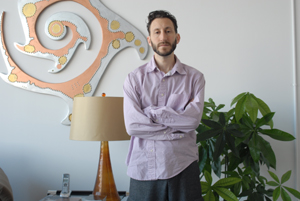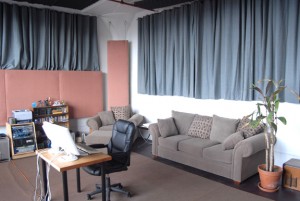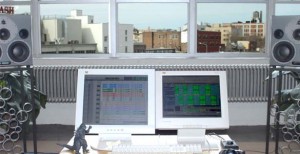The Spirit of NYC Mastering: Get Inside the Ears of James Cruz and Zeitgeist Sound Studios
LONG ISLAND CITY, QUEENS: Scratch below the surface of any of today’s independent masring engineers, and most likely you’ll find a team player there. There are a lot of one-person shops dotting the NYC landscape, but these individual practitioners weren’t always flying solo.
Case in point: James Cruz, founder and sole proprietor of Zeitgiest Sound Studios in Long Island City. In another dimension – circa 2004 – Cruz was a young addition to a mastering dream team operating within the dearly departed Sony Studios. His collaborators there were some of the heaviest hitters – then and now – in the industry: Vic Anesini, Vlado Meller, Joseph M. Palmaccio, Darcy Proper, and Mark Wilder. The late, great technical genius Dave Smith, VP of Sony Music Engineering, oversaw it all.
Change being the constant that it is, in 2007, Sony Studios closed to make way for something else deemed more useful. The All Stars are now scattered across the planet, but Cruz, a longtime resident of Astoria, made it just across the river to Long Island City to found scenic Zeitgeist. Since settling in, his credits have included the last three Calle 13 albums (winners of a total of seven Latin GRAMMYS and two GRAMMYS), Mary Mary, Cee Lo, Three-6 Mafia, Natasha Bedingfield, and more.
Here, Cruz cues us in on many things mastering – why he stays in the box, how artists can make the most of their session, and the beauty of being your own boss.
Tell us about the “signal path” that got you into mastering.
Ha! If you want me to start at the top…Just about out of college I sent resumes all over town — I wanted to be a record or mix engineer. Troy Germano at the Hit Factory called me for an interview and hired me as a GA (General Assistant) in the mastering department. At the time I had never heard of mastering and knew nothing about it, but he said to give it a try and eventually I can move over to “the other side.”
This was at the time The Hit Factory was at its peak: The engineering staff consisted of Herb Powers, Tom Coyne, Chris Gehringer and Roger Talkov. At the time Roger was one of the few people in New York with a new workstation called Sonic Solutions, and he was betting on it being “the future of the business.” Roger needed to move on, I decided that I would learn the system, and I was literally learning trial-by-fire style doing sessions for Celine Dion and Jim Steinman two days later.
Soon after that Tom went over to Sterling Sound so I picked up the computer, put it in his room and said “mine.” I was doing Toni Braxton sessions with LA Reid the next week. All while still making coffee and running the library. Then I learned how to cut records from Herbie – one of the best vinyl cutters ever and learned my EQ chops from Gehringer. It was a pretty special time. I liked it so much that here I am 20 years later. I never went to “the other side.”
That sounds a little like how I got started writing about pro audio! Your mastering career led you to a nice distinction – one of the final group that made up Sony Mastering: What do you feel was special about the people that were there? And the facility, for that matter, at the time that it got shut down in 2007?
Sony was amazing. The Hit Factory was great for many reasons but Sony was amazing. It was one of the most underappreciated and under-used facilities ever. Never again will there be a place like it: You could walk in with nothing, book a production room, record, mix, master and duplicate your album. Then you could go down the hall and shoot and edit your video and do artwork, and even do a live broadcast from the soundstage.
Another thing about it was the technical staff. By far the best in the business. I could ask them for the most bizarre setups you could think of and it would be done in 30 minutes, without ever having to rent gear. The mic locker was epic.
Then there were the engineers. Of course everyone knows the juggernaut that is Vlado Meller, but on top of that was Mark Wilder, a pair of golden ears if there ever was one, and Vic Anesini who did fantastic work. It was a place where we all worked on making each other better and it was always great to have these guys to give an opinion on an EQ or compressor setting. I feel like The Hit Factory was a long training session and Sony is really where I came into myself as an engineer.
I always wondered why it was so quiet every time I was at Sony. After that, why did you decide to go solo and set up Zeitgeist, rather than joining another mastering facility?
Honestly, Sony shut down and I had no interest in working for someone else anymore. I couldn’t really see myself at Sterling or Masterdisk so I didn’t even pursue it. I figured I had already worked in two of the best spots ever and now it was time to do my own thing. I also like the idea of being completely responsible for myself and not having to answer to anyone.
So how would you describe what you’ve created in Zeitgeist – what were your objectives for the room? How did you set it up?
The most important thing for me was the vibe. Even though I’ve worked in these amazing studios, all the rooms always felt very cold and sterile – there’s really only so much you can do with a black couch and lava lamps. So first and foremost I wanted sunlight.
I also went in the complete opposite direction of the “modern mastering room” and went back to what it was originally intended to be, and that’s the best-sounding living room stereo in the world. So I did just that: I built a giant living room with tons of comfort and a front window that’s 20’ long by 8 ½’ high — I barely even need to use electric lighting anymore.
Zeitgeist is the Comfort Zone. You also mentioned to me that you master virtually 100% in the box. Why is it that?
Pristine signal flow — mastering rule Number One. When I started everything was on tape. It came in on ½” (sometimes DAT) and ended up on lacquer and/or UMatic. There was always a physical medium so there was always multiple pieces of gear, a bunch of feet of wire, patch bays etc…
Even though everything was as high quality as possible, it always imparted a sound. Sometimes it was good, sometimes it was bad. Along the way I noticed everything started to go all-digital — started with DAT then recordable CD. So I started to back off on the analog gear. I didn’t want to convert to analog, go through a bunch of stuff, then have to go back to digital. Eventually it went to all WAV files so I found no reason to ever leave the box.
I’m using very high quality mastering grade plug-ins and my signal flow is as short as possible. Do I miss analog stuff? Yes. Very much. I would much prefer to turn a knob then adjust a trackball! There are definitely some advantages to doing it this way, though, besides the signal flow. It allows me to work much faster, which benefits the client in the end. I also have a lot more flexibility than I ever had with analog stuff.
There’s always a tradeoff, in either direction. How is your workstation configured?
My workstation is the Sequoia by Magix and my main EQ is the Orange Linear Phase by Algorithmix. I can’t live without them. It runs on Windows XP and the computer was custom built by Sony’s computer genius Jim Yates.
It’s a powerhouse of a system and extremely stable. It’s so over-engineered I have seen no reason to update it yet, to be very honest. My next batch of plug-ins will probably be the Sonnox Oxford stuff – it’s not new but it is some great-sounding stuff. Universal Audio is also doing some very cool stuff with all their emulations.
Turning around to what’s coming into your system, what would you say are the trends you’re seeing in terms of the recording techniques and audio quality of the music you’re getting? How are projects evolving, and how is that affecting the way you approach your job?
Let me start here, and this is as diplomatic as possible: owning Pro Tools doesn’t make you a recording engineer, in the same way that owning a frying pan doesn’t make you a chef. That being said there are more and more projects being done in smaller project studios and fewer people are actually involved in the process. There is actually a very good article in a current magazine about the engineer becoming a loner, where in the days of the larger studios there were always other people around to give opinions and push you to be better.
That’s a major change that’s affecting the way things are done. As far as audio quality, it’s always been hit or miss. There have always been bad engineers and great engineers. As technology gets cheaper there do seem to be more and more engineers though.
On that topic, you said that client education is something you’re a big proponent of. What’s an example of a correctable mistake you often hear on the projects you get – something that people could easily fix so that you can deliver a better master?
I love for new clients to call me before the session and ask as many questions as they want. I am a big believer in one-on-one communication with the client. It benefits everybody.
The biggest mistakes I get are too much compression/limiting – see “level wars” discussions in every audio publication and message board written in the last 10 years — and the tops and tails of the tracks not being right. If your mix engineer is adding a limiter on the two-mix just to make it loud, tell him to remove it before sending it to mastering. Your mastering engineer should be able to make your track loud without wrecking all the wonderful dynamic range that makes music connect on an emotional level.
It’s also helpful to leave a second or two of air before your song. Don’t start your WAV right on the music, let it breathe a bit. Your mastering person can trim it for you. And lastly, that applies to the end of the track too: Leave some air at the end so your mastering engineer has some room to work, especially when sequencing an album. The worst, and costly, mistake is not being prepared. Call your engineer before the session and get in detail the way that things should be done, if you have any questions.
That’s some super-solid advice! Things are pretty competitive here in the NYC mastering scene, right? How are things evolving for you and your competition?
I think the smaller guys are making a pretty serious play. To be very honest, and I mean this with the utmost of respect, I don’t really see how the giant muti-room places can survive with that business model much longer. The overhead is just too high. As budgets continue to shrink and the web continues to shut down labels it’s going to be the boutique studios that will be able to keep up.
On another tip, who are some music innovators that have inspired you – be they engineers, artists, business people, chefs…?
Wow. Good one — there are so many. In no particular order: Jimmy Page, Pink Floyd, Brian Eno, Daniel Lanois, Pete Townsend, Geoff Emerick, George Martin, Brendan O’ Brien, Jim Thirwell, Jon Brion, Joe Strummer, The Talking Heads and XTC. Just to name a few.
That’s a heady mix! Finally, when you sit down to master a record – whether it’s an indie artist or major label hit – what’s the big payoff?
I love doing an attended session and playing the before-and-after for a client and seeing their face light up. That’s a lot of fun for me. When everything is complete, the client sits down and listens to the complete product, and says “YES!” that makes me very happy.
File under “What a Feeeeeeeling!” Anything else to add?
I need a vacation. It’s been way too long.
Amen!
Please note: When you buy products through links on this page, we may earn an affiliate commission.









